How to correctly determine the distance from a gas tank to a residential building: choose a suitable location on the site
The use of “blue fuel” for domestic needs has a significant drawback - the difficulty in implementing delivery and storage. This shortcoming was overcome thanks to a gas holder - a “tank” for liquefied hydrocarbon gas.
The installation of autonomous gasification is subject to a set of requirements and standards. First of all, it is necessary to evaluate the parameters of the site, determine the distance from the gas tank to the residential building, nearby buildings and communications.
The content of the article:
Site assessment: possibility of installing a gas tank
The main gasification of remote villages has not yet been completed, and many settlements remain without convenient “blue fuel”. An alternative solution to centralized gas supply is the installation of a gas tank and the arrangement of an autonomous network.
A gas holder is a monolithic tank for storing natural gas. Structurally, the tank is made in the form of a tank with a neck. In the upper part there are elements that control the pressure and remaining fuel.
Undoubtedly, the operation of any gas equipment is associated with a certain risk, therefore, to organize autonomous gasification, a number of requirements are imposed on the location and installation technology of the gas tank.
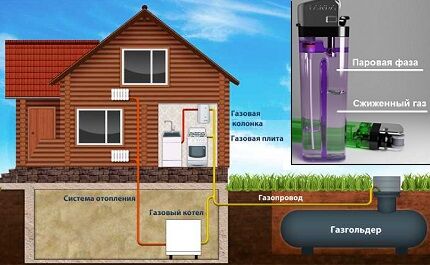
The site for installation of a gas storage facility is assessed according to the following criteria:
- relief;
- the composition of the underlying and enclosing soil layers and the proximity of groundwater;
- availability of water intake points, residential, utility and public premises.
Relief. The area selected for surface mounting must be level. This requirement is especially relevant when installing ground-based modifications - installation on a slope is prohibited.
Priming. It is permissible to place a gas storage facility in soil masses with different moisture contents. The convenience of excavation work and the choice of gas holder type will depend on the physical and mechanical properties of rocks.
If there is no risk of flooding of the fittings, models without a high neck can be used. As an option, a tank is suitable, where the bends are attached to welded pipes 12 cm long - this is the “safety” height, if there are doubts about flooding.
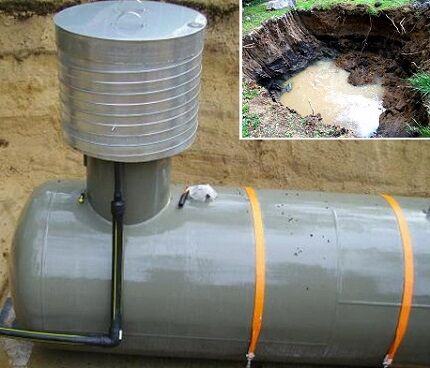
Water is an excellent conductor of heat waves, and the process of evaporation of the propane-butane mixture is determined by the temperature of the environment. The higher the indicator, the more intense the process. Installation work in low-moisture rocks is simpler, but the environment for normal gas tank operation is less favorable.
Coarse soil can be dangerous, especially if its components are weakly rounded, i.e. with sharp edges. Boulders, pebbles and large crushed stone complicate the installation of equipment, and the mass of gravel and debris creates additional stress on the gas pipeline.
In most cases, installation selected gas tank a pit is being developed, which is recommended to be filled with river or quarry sand after the structure is immersed.
Proximity to water intake sources. According to building regulations, the minimum distance from a gas tank to a reservoir (well, well) is 15 m, and to a water main - 5 m.
Neighborhood with buildings. Fire safety distances from liquefied gas tanks to structures are indicated in paragraph 8.1.6 of the regulatory document “Gas distribution systems” (SNiP 42-01-2002). The next section is devoted to this issue.
It is more practical to place the gas holder closer to the gate for unhindered access of the gas carrier and filling the tank.
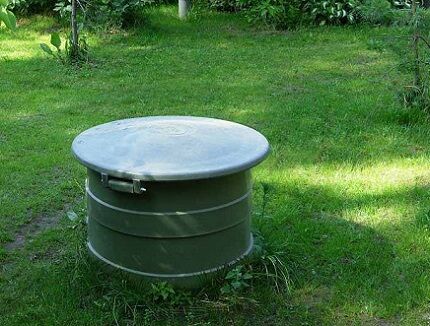
In addition, concreting or paving the site, as well as organizing a parking space and planting trees, is prohibited.
Fire distances to protected objects
Determining the optimal location for gas holder installations on the site depends on the volume of the tank and the method of its installation: underground or above-ground installation. For each option, strict standards are defined, the neglect of which is unacceptable due to explosive, environmental and fire safety requirements.
Volume is a determining parameter for the distance of buildings
Not only the location of the container on the site, but also the ease of use depends on the correct choice of volume. The capacity of the gas tank is selected so that one refill is enough for 1-1.5 years. The volume is calculated based on the area of the house.
According to standards, 20 liters of “blue fuel” per year are consumed to heat 1 square meter of housing.If gas is simultaneously used for cooking and hot water supply, the figure increases to 27 l/year.
Knowing the dimensions of the house and the needs of the residents, it is easy to perform the calculation. For example, for a cottage of 200 sq.m, a gas holder with a volume of 4000 liters or more is suitable. An alternative option is to determine the size of the tank based on the power of the boiler installation. For example, a 50 W boiler will require a 5000 liter gas holder.
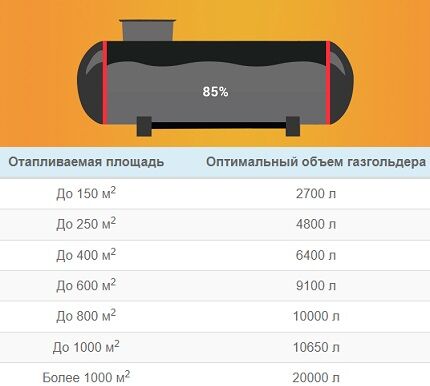
Standards for the location of underground gas tanks
For year-round operation in cold winter conditions, it is necessary to choose an underground “storage”. The module is immersed below the soil freezing line, which supports the natural evaporation of gas at sub-zero temperatures outside.
General standards for distance from underground tanks of any volume:
- sports grounds, children's playgrounds, garages - 10 m;
- underground pipeline for heating mains and sewerage – 3.5 m;
- external communications not included in the backup equipment group – 5 m;
- edge of the carriageway of a non-high-speed road for 1-2 lanes – 5 m;
- highways and expressways with 3 or more lanes – 10 m;
- access tram track, industrial railway tracks - 10 m.
The distance to buildings for various purposes is determined by the capacity of the liquefied gas tank. A gradation of values is provided for “storage” volumes: up to 10 cubic meters, 10-20 cubic meters, 20-50 cubic meters.
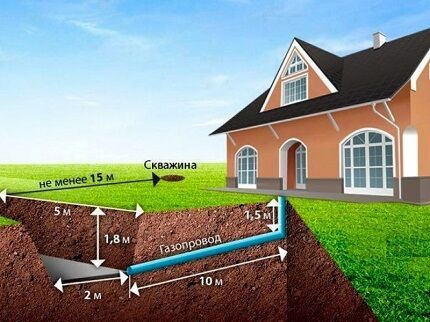
Various standards are provided for installation of a private “gas storage” regarding production premises. The range of distances is 8-15 m. The distance to general purpose railways is also regulated - 20-30 m, depending on the displacement of the gas tank.
SNiP allows for a reduction in the interval between a residential building and a “gas vat” by 50%. However, such a decision must be justified on technical grounds and approved by the local gas distribution systems department.
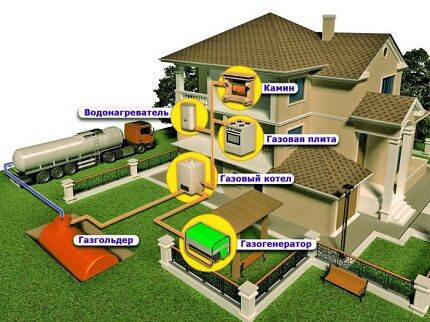
In addition to the requirements for the distance of the gas tank from various objects, there is a list of rules for regulating underground “storage”:
- installation depth - at least 60 cm from the top wall of the tank to the ground surface;
- the distance between underground gas tanks is at least 1 m;
- the neck and fittings of the container must remain freely accessible.
Regardless of the displacement, the underground tank is mounted on a foundation - a concrete slab. The base prevents the tank from “floating” in the event of ground movement.
Subtleties of installing an above-ground tank
The use of a ground-based gas tank has several significant advantages: simplicity, speed of installation and reduction in the intensity of metal corrosion. Local damage is easy to detect and correct in a timely manner.
However, this type of equipment is rarely used to supply gas to a private home. The main reason is a significant decrease in system performance in winter.At subzero temperatures (below -0.5°C), liquefied gas does not evaporate naturally.
To support the process, the gas tank must be equipped with an evaporator. With insignificant consumption of “blue fuel”, capital investments in gasification take a very long time to pay off. Due to the above-ground location, the requirements for fire safety distances from the gas storage facility to buildings and other objects are more stringent.
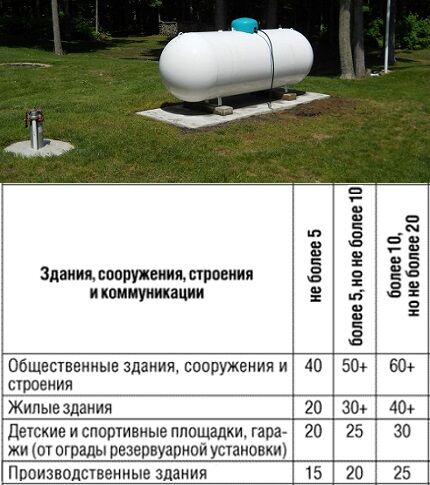
Additional restrictions on the location of the above-ground “gas vat”:
- general purpose railways – 25-30-40 m in accordance with the volume;
- local tram and railway tracks – 20 m;
- roads IV-V categories (1-2 lanes) – 10 m, I-III categories (from 3 lanes) – 20 m.
For safety reasons, a kind of open cap is installed above the gas tank, protecting the module from direct sunlight and precipitation. Overheating of the tank or lightning can lead to an explosion, and rain and snow can lead to accelerated corrosion.
Placement of mobile gas storage facilities
A mini-gas tank is a capacious gas cylinder with a volume of up to 500 cubic meters, equipped with the fittings required for safe operation: a reducer, a level gauge and safety valves. The equipment is characterized by compact dimensions, for example, the parameters of a 480 liter tank are: length - 2 m, diameter - 60 cm.
When used correctly mini gas tank its service life is the same as that of a full-size gas tank.The mini-model is placed permanently or installed on a trailer, which ensures the mobility of the gas storage.
Refueling mobile capacity is significantly simplified, since it becomes possible both at the location and at the gas filling station.
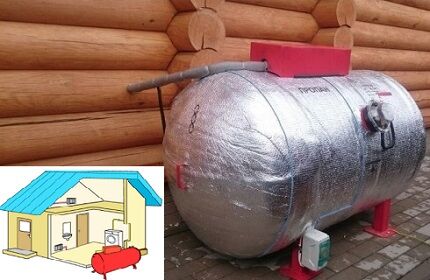
According to SP 63.13330 of 2011, the minimum distance from the house to a small gas tank is acceptable, namely placement directly next to the wall. The distance between the equipment and other protected objects is not specified.
Mini-gas tanks are in demand to ensure autonomous gasification of premises with relatively low or seasonal fuel consumption: country houses, heating cafe areas, hotels. The reservoir is often used as a backup source of gas in case of interruptions in the centralized pipeline.
Set of requirements for laying a gas pipeline
Certain standardized standards are also required for the installation of a gas pipeline running from the gas tank to the house. Gas is supplied to the premises via an underground pipeline through the basement inlet. Safety rules prohibit introducing a gas pipeline into a house underground.
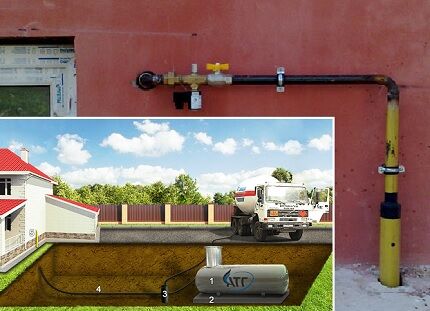
General requirements for laying a gas pipeline in the gas tank-house section:
- track depth – at least 1.7 m;
- trench width - there are no strict restrictions, the value depends on the footage of the gas pipeline and the quality of the soil;
- the minimum slope towards the condensate collector is 1 cm per 1 m (no more than 5°), the maximum slope is 100 mm;
- the distance from the highway to the foundations of buildings is 2 m or more;
- the distance to parallel located communications is 1 m, with a cross arrangement – 2 m in height.
The underground gas pipeline line is installed from high-density polyethylene pipes containing nitrile. Ground line - steel gas pipes. The polymer pipeline should not reach the point where the ground temperature drops to -20°C or less.
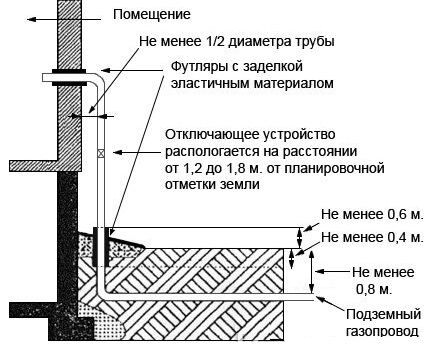
Safety of gas tank operation
Despite all the advantages of autonomous gasification, many consumers are scared off by the thought of the risks of storing a flammable substance on a site near a residential building.
To ensure safety, it is not enough to maintain the required distances during installation; it is necessary to comply with all conditions for refueling, operation and maintenance of the gas holder installation.
Operating rules:
- Preservation of an inexhaustible supply - about ¼ of the volume. When all the fuel is used, a vacuum is formed in the container; further refueling in violation of the technology may result in an explosion.
- Filling of the gas tank exclusively by a specialized company. Insignificant savings on the services of unqualified gas workers can lead to a fire.
- Monitoring the operation of the safety valve. Timely troubleshooting will prevent an emergency.
- Prevent gas leakage.The leakage of “blue fuel” is the most dangerous - the propane-butane mixture “spreads” downwards, since it is heavier than air.
There is a possibility of fuel leakage if the tank is damaged, the fittings are faulty, unqualified repairs or refueling are performed, as well as if the gas distribution system elements are not hermetically sealed.
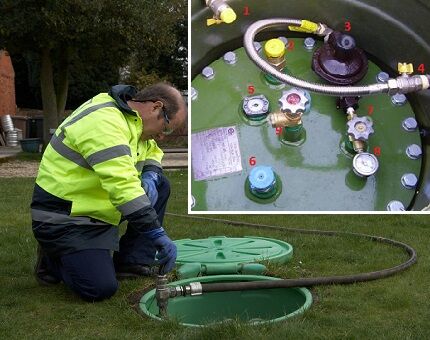
Mandatory precautions include the use of lightning protection and grounding. It is prohibited to carry out welding work or light a fire near the gas holder.
Will familiarize you with standard prices for installing a gas tank next article, in which all items of upcoming expenses are analyzed in detail and recommendations for possible savings are given.
Conclusions and useful video on the topic
Video report on the operation of an installed gas tank for servicing a private home. The review discusses the equipment that ensures safe use and the permissible distances to objects on the site:

One of the main requirements for the safe operation of a gas tank is compliance with the standardized distances from a residential building and other objects to the gas storage. If the conditions of the site itself are unsatisfactory, some leniency regarding the boundary distances is permissible. It is better to entrust the assessment of the installation site and installation to a specialized company.
Tell us about how you selected a place on your personal property to install a gas tank. It is possible that you have useful information that will be useful to site visitors. Please write comments in the block below, post photos related to the topic of the article, and ask questions.
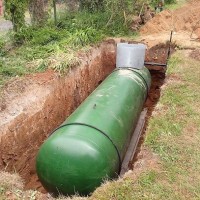
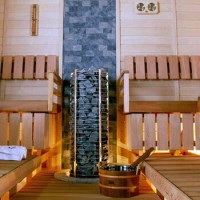
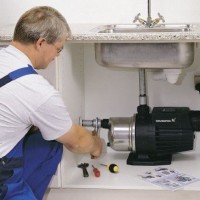
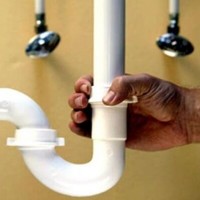
I worked for several years in a company engaged in autonomous gasification. In practice, the distance of underground gas tanks to residential buildings almost never meets the established requirements. As a rule, the plots are small, and people want to save the space occupied by the gas holder. Sometimes there is simply no way to mark it, except near the house itself. The fact is that in Russia only legal entities are controlled by Rostechnadzor. No one checks citizens and their homes for violations of the law regarding violations of joint ventures and other regulatory documents. Everyone violates these norms at their own peril and risk. To be fair, I would add that in Europe, for example, the distances established by law are much shorter, and if the equipment is of high quality and installed by competent specialists, any risks are minimal.
I still can’t understand the feasibility of this event... So I calculated the gas consumption for my house, I have the same amount of money to heat with electricity (the most expensive resource) (in winter) as with buried gas. But what a huge amount of work needs to be done to arrange the gas tank, and a project to do for wiring around the house too.
With indentations, it’s also not so simple: you step back from your house, but you end up at your neighbor’s. In old garden societies the plots are small.And new ones are cut in grain places, and there is gasification there.
I don’t know how you calculated that heating with electricity is the same price as gas from a gas holder. This is wrong. Of course, it is more expensive than main gas, but much cheaper than electricity. The main problem is that you will initially have to spend a lot of money on a gas tank and run around for permits.
“Run for permits.” What permissions?
I would like people to be required to obtain permits for installation and run through authorities, so that there would be no desire to drag all sorts of nonsense into the house, especially when a natural gas pipeline runs along the fence. We got sick of “meaningless toys” in the yard, came and stuck them 2 meters from the house, standing in the sun, “beauty.” And the installers were charming, they sold it and made money. We need to find someone to argue with, how soon will the man finish playing with this barrel?! I think it will last until summer...(if anything, it’s autumn now;)).